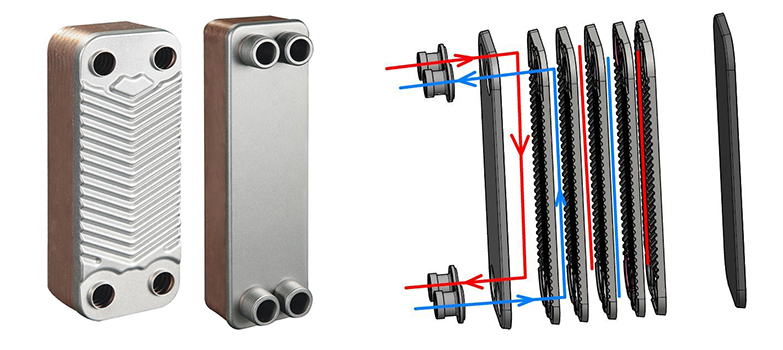Brazed Plate Heat Exchanger in Refrigeration System
The application of brazed plate heat exchangers in the refrigeration industry is very common. The brazed plate heat exchanger is an efficient and compact heat exchange equipment. In the 1880s, it was successfully developed as a continuous low-temperature sterilizer, and it began to be used in the food industry in the 1920s. Due to the uniqueness of the brazed plate heat exchanger in manufacturing and use, it is widely used in petroleum, chemical, light industry, electric power, metallurgy, machinery, energy and other industrial fields, thus becoming a very competitive variety in the heat exchanger family. In addition, brazed plate heat exchangers are also used in the refrigeration field. Let’s talk about its application and development below.
In refrigeration system, heat exchanger is an indispensable refrigeration equipment. Heat exchange equipment such as condensers, evaporators, regenerators and intercoolers not only account for more than 50% of the entire refrigeration device in terms of weight, volume and metal consumption, but also have a significant impact on the refrigeration performance. Therefore, enhancing the heat transfer of refrigeration heat exchangers, reducing weight and volume, and lowering the metal consumption have always been the development direction of refrigeration technology. Now, a new, fully welded brazed plate heat exchanger has been gradually applied in refrigeration technology system, and has shown strong development potential.
Benefits of brazed plate heat exchanger in refrigeration system
Compared with shell and tube heat exchangers for refrigeration, brazed plate heat exchangers have the following characteristics in addition to the general benefits of plate heat exchangers:
- The filling amount of refrigerant is relatively small, which is conducive to environmental protection and reduction of operating costs.
Both the shell and tube sides of the shell and tube heat exchanger have large volumes.
To make the refrigeration system work properly, a large amount of refrigerant must be filled. This may cause environmental pollution. The brazed plate heat exchanger has a small volume on one hand and a small spacing on the other hand. - Low freezing tendency and high freeze resistance.
Since water can form a high degree of turbulence in the brazed plate heat exchanger at low flow rates, and the temperature distribution is very uniform, the freezing tendency of the chilled water is reduced. Even if freezing occurs, it is more able to withstand the pressure generated by freezing. It is not as easy to cause the heat pipe to burst and crack like the shell and tube heat exchanger, and can continue to be used after freezing. - Thorough evaporation and high economy.
When the refrigerant evaporates in the brazed plate heat exchanger, it is easy to achieve complete evaporation to the degree of no liquidity. Therefore, in most cases, the refrigeration system does not need to be equipped with a gas-liquid separator. Moreover, it is characterized by simple unification, easy and convenient installation. In addition, its maintenance and transportation can save and reduce costs.

The application of brazed plate heat exchanger in condensation system
In general, the purpose of the condensation evaporator of brazed plate heat exchanger is to cool the process fluid by the refrigerant fluid that evaporates at a constant temperature.
Up to now, its most common application is to cool the water of an air conditioning system from 12℃ to 7℃.
In the brazed plate heat exchanger, the refrigerant fluid enters the liquid phase at a high speed and evaporates from the bottom up through the plate heat exchanger(the quality of imported steam actually rises from 0.2 to 0.3), thereby removing heat from the fluid flowing to the other side.
The last part of brazed plate exchanger is used to overheat the vaporized gas so that there is no backflow of liquid particles in the compressor, thereby avoiding damage to the compressor itself.
The most important part of the evaporation process is the correct distribution of the two-phase fluid at the inlet of the heat exchanger. The goal is to introduce the same gas flow in each channel of the brazed plate heat exchanger along all the plates.
On the other hand, when the brazed plate heat exchanger condenser is the last one, we also have a gaseous refrigerant fluid (usually at a high temperature of about 60-70°C). The condensation of this refrigerant fluid comes at the expense of a fluid. The other side of the exchanger is heating up. Normally, the condensation temperature of the refrigerant is about 40℃, while the fluid temperature on the other side is 30-35℃. The last part of the brazed plate heat exchanger is used to subcool the condensate by a few degrees Celsius, usually 3-4℃.
In this case, the overheated gas enters from the top, descends through the exchange plate, is condensed until it becomes liquid, and then drains at the bottom.

